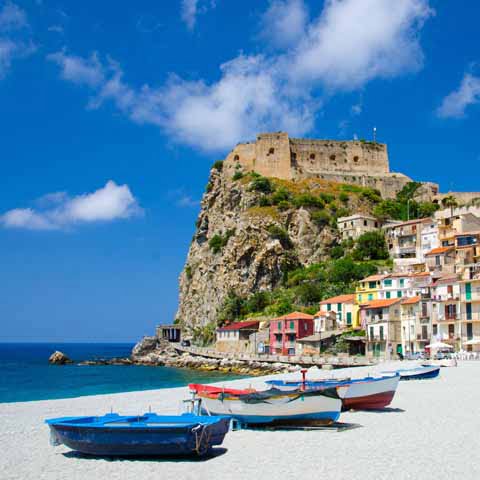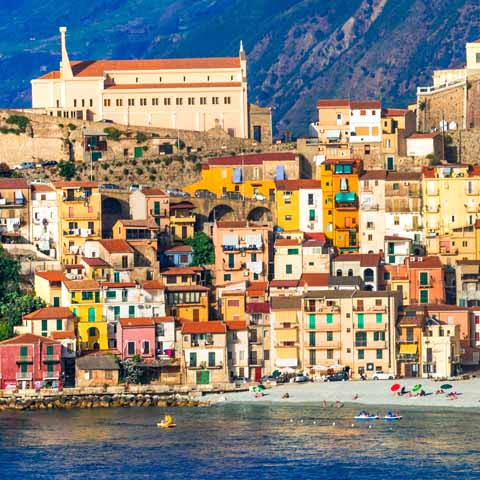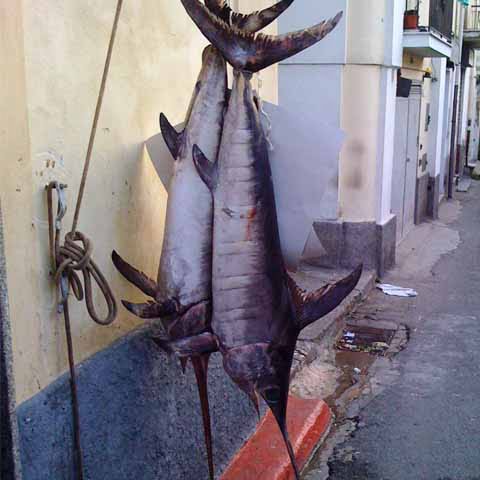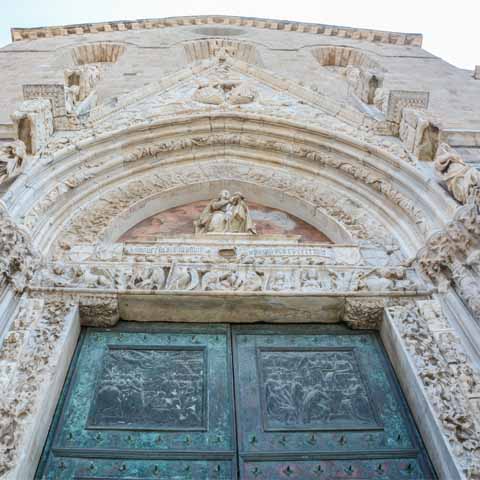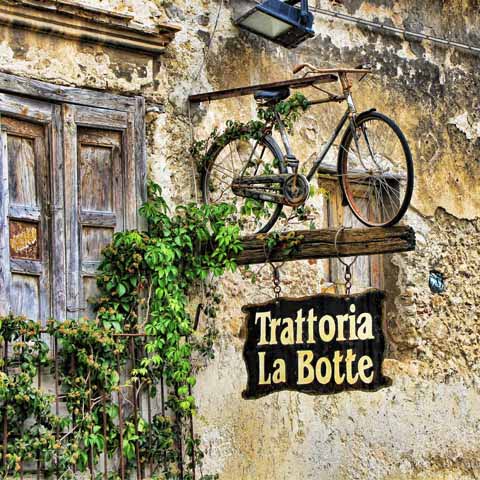In the southernmost tip of Italy sits one of the country’s best kept secrets, the city of Reggio Calabria. The town boasts a beautiful dichotomy of the craggy Aspromonte Mountains and the sparkling waters of the Strait of Messina and Ionian Sea. It is one of the oldest cities in the region of Calabria and today is one of the most populous. Whether it is the call of the mountains or the peace of the waters that you seek, Reggio Calabria is full of amazing opportunities for adventure.
FESTIVAL & EVENTS
The primary religious festival celebrated annually in Reggio Calabria is the Festival of the Madonna della Consolazione. The event, which includes a festival and solemn procession, is largely centered on a work of art by Reggio artist Nicolo Andrea Capriolo from the mid-sixteenth century. The painting shows the Madonna on a throne with baby Jesus joyfully sitting in her lap. On either side of the Madonna stand the religious figures of Saint Francis and Saint Anthony. The Madonna is said to have protected Reggio Calabria over the years from harmful influences and events and is expected to do so in the years to come.
The festival is a celebration of the painting, but even more so a celebration of its mystic movements. Legend says that the painting was displayed originally at the Cathedral of Reggio Calabria before disappearing and eventually being found on the Eremo Hill. Once recovered, the painting was returned to the Cathedral only to disappear again to Eremo. Ultimately, the painting’s undisputed home became that which the painting seemed to choose, the Basilica of Eremo.
The annual procession begins the second Saturday of September. The painting is reverently carried from the Basilica of Eremo to the Cathedral of Reggio Calabria. The following Tuesday the painting is carried again throughout parts of the city before returning to the cathedral. After two months, another procession returns the artwork to the Basilica of Eremo until the following September.
The festival is well attended and is thought to have been observed for approximately five hundred years. In addition to the procession, a festival including dancing, puppets, and delicious food takes place.
Several other festivities take place in the towns that are part of the metropolitan area of Reggio Calabria. One example is the Feast of Sant’Antonio Abate in Roccella Ionica, which features a blessing of fire and a blessing of pets. Nearby Taurianova comes alive during its Infiorata when a colorful carpet of 100,000 flowers is arranged in the city center. Many local festivals also feature papier-mâché giants, an important part of the local folklore, such as the Night of the Giants in Polistena.
OUTDOOR
In the center of Reggio Calabria is Piazza de Nava, a historic square. The square is named after Giuseppe De Nava, a local politician and nobleman from the early twentieth century. The popular square is also home to the Reggio Calabria Museo Nazionale and part of one of the main streets of the city, Corso Garibaldi. A monument of note here is a statue dedicated to Giuseppe De Nava. A magnificent statue with stairs, the structure is sometimes a resting place for a pedestrian hoping to escape the sun under the shade of one of the nearby small trees.
Also in the center of the city and just across the way from Piazza De Nava is Piazza Indipendenza. The square is dedicated to Italian independence and is often a site for summer concerts or shows. A particular curiosity of this square is a central fountain that has been rebuilt several times but has still been unable to meet the locals’ approval. At one point the fountain was even converted to a flowerbed that served as a roundabout for cars where the streets converge.
Piazza Duomo is situated directly in front of the Cathedral of Reggio Calabria. Until the sixteenth century, the square was actually known by a different name, which was Tocco Grande. At the time, the city was divided into two “tocchi” and the mayors for each of the tocchi were elected in the main city squares. One election took place in Tocco Grande (now Piazza Duomo), while the other was held in Tocco Piccolo (now Piazza Italia).
Though everyone calls it Piazza Italia, the official name of the square is Piazza Vittorio Emanuele II. Located in the heart of the city, Piazza Italia hosts Reggio Calabria’s most important administrative buildings. In the center of the square stands a nineteenth century monument dedicated to the Unification of Italy by Rocco Larussa.
The shoreline of the city directly faces the Strait of Messina which eventually opens up into the Ionian Sea and offers an abundance of breathtaking and peaceful views. Whether visitors choose to take in the sights via a ferry ride or from the promenade, the scenery will not disappoint. While in the area, be sure not to miss the magnificent Monument of Athena and the Arena Dello Stretto, a beautiful and ancient Greek outdoor amphitheater.
Reggio Calabria features countless archeological areas that may be of interest to travelers. The Greek Walls are an excellent example. Originally built during the mid-fourth century BC, the walls were renovated and rebuilt several times.
The Roman Baths are another must-see. Here, travelers can learn more about the history of Ancient Rome and admire remarkable mosaics that date back to the second and third century BC.
INDOOR
The Reggio Calabria Museo Archeologico Nazionale is one of the most renowned and historic buildings that visitors frequent. The stately off-white building of four stories sits just behind the beach promenade. Although the museum is known for its many exhibits which span artifacts from pre-Magna Graecia, Magna Graecia, and Helenistic Necropolis, perhaps none of them are as well-known as the Bronzi di Riace. These two famous bronze statues thought to date back to fifth century BC were discovered in the Ionian Sea in the late twentieth century after laying at the bottom of the sea for almost two thousand years. Today the Riace Bronzes have become a symbol of the city of Reggio Calabria and the Calabria region as a whole.
The Diocesan Museum was commanded by Monsignor Giovanni Ferro in the mid-twentieth century. The museum protects the history and artistic heritage of the churches of the Archdiocese and the Diocese of Bova. The ancient structure of circa late-nineteenth century in the center of town has an extensive collection of artifacts amassed by bishops and clergy of the city over the years. It is not unusual to see gold and bronze altar pieces, jewelry, holy trinkets, and art within the walls of this museum.
Close to the center of the city is the Planetario Provinciale di Reggio Calabria, or planetarium known also as Planetario Provinciale Pythatoras. The planetarium’s exterior is quite modern as it was built in the very early twenty-first century. The most striking characteristic of the structure is the mirror-like dome that dazzles when the sun shines brightly. The planetarium offers some truly out of this world views of the planets and heavens above.
To learn more about Reggio Calabria’s most famous local product, be sure to visit the Bergamot Museum. Here, visitors can become familiar with the citrus fruit’s history and uses. A variety of historic instruments and equipment are on display in the museum accompanied by photographs.
FAMILY
One of the main thoroughfares of the city, Corso Garibaldi, is quite long as it stretches from the Calopinace River all the way to the National Museum and is parallel to the shoreline. The street offers many pedestrian-only areas prime for fabulous shopping that includes everything from high-end stores and boutiques to quaint cafes and restaurants. Corso Garibaldi is hopping with music and laughter, especially at several of the local bars once the sun sets.
If the family is looking forward to enjoying the sunshine and exploring the coast, there is no better place than the Lungomare Falcomata. This approximately one mile cobblestone walkway complete with charming benches and lighting for an evening stroll, or passeggiata, is a favorite locale for residents and visitors alike. The walkway is particularly popular and lively in the evenings when people are out and about after the sun goes down.
KIDS
For children enthralled with adventure-filled fairytales full of beautiful princesses and valiant knights, the Aragonese Castle of Reggio Calabria will not disappoint. The medieval structure is estimated to be from the sixth century. Throughout the years, the castle has unfortunately sustained some damage but has been carefully restored. It is not uncommon for the castle to be home to art exhibitions. From atop the towers of the Aragonese Castle is a stunning view of the sparkling waters of the Strait of Messina.
After much sightseeing and touring, the children may very well just crave some down time at the beach. Several stretches of beach along the coast of Reggio Calabria offer some sand and pebble coastline with the beautiful waters of the Ionian Sea. The beaches may get quite busy during the weekends, but are generally far less crowded during the work week.
After a hot day in the sun at the beach, what else is there to do but to enjoy an icy cold treat? Take the family to one of the city’s best gelato shops and enjoy the cool respite from a long day of fun. There are a variety of unique flavors to try, such as bergamot and almond.
UNIQUE EXPERIENCES
One of the more unique experiences in Reggio Calabria is not one you will see all the time. Fata Morgana’s appearance is almost as mysterious as the vision it creates. It is the name of a mirage that can be observed in the Strait of Messina when light rays are strongly inflected by passing through air layers of different temperatures. The resulting effect is a distorted image that tricks the eye into thinking things are nearer than they actually are. In some cases, if standing on the shore of Reggio Calabria, some onlookers have said they could see very specific details from the opposing shore of Sicily, such as cars and houses.
The mirage itself is interesting, but the legend that goes with it is equally entertaining. Legend says that an ancient king stood upon the shores of Reggio Calabria trying to figure out how he could reach the coast of Sicily. It is said that Fata Morgana, a figure in Celtic mythology, created the mirage to make Sicily look closer, therefore enticing the king to his death. Thinking he could easily reach the shore, the king dove into the water only to drown in the Strait of Messina.
Reggio Calabria is a city of much mystery, mythology, and beauty. Any trip to this thriving city is an exciting adventure in and of itself that is well worth the journey. Make plans now to visit Reggio Calabria and experience the majesty of the nearby Aspromonte Mountains and the gorgeous waters of the Strait of Messina and the Ionian Sea.
Don't just see Italy, live it.
Your dream trip to Italy has never been closer
No more endlessly scrolling travel sites. Our travel experts will craft the perfect, one-of-a-kind trip just for you.

300+
DESTINATIONS
We offer more Italian destinations than any travel site. Do and see more with Trips 2 Italy.
1 (of a kind)
ITINERARIES
Because your dream trip to Italy should be designed for you, not for the masses.
100%
PEACE OF MIND
From flights and accommodations, to food and activities - we take care of every detail.
